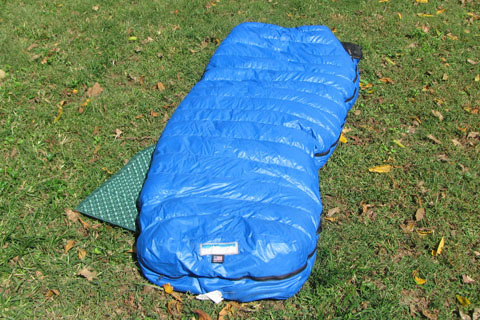| 493 | Trail Sense - Sleeping Systems | 2011-10-10 |

In the Trail Sense series over the last few weeks, we have discussed pack weight with regards to backpacks and tents (or shelters). Rounding out the big three weight items that go in our pack is the sleeping gear. I have been on trips where I had a lousy pack; but my good sleeping bag still allowed me a good nights rest. And I have been on trips where I had a not so great of a shelter; but my sleeping bag still gave me warmth and protection from the elements. I have also been on trips with an inferior sleeping bag or pad; but when I couldn't sleep, even with a great pack and tent, then the trip turns bad. On my Canadian Rockies trip I would have traded anything for a simple sleeping pad!
For backpackers/hikers to comfortably carry a pack, we must keep the weight as light as possible. As guidelines - the pack itself should weight less than three pounds, the shelter should be less than two pounds per person, and the sleeping system should be less than three pounds per person. That is only eight pounds (or less) total. Of course the total pack will weigh more than eight pounds; but this base number will be there on every backpacking trip, just add the kitchen, food, water and some clothes to match the trips length and weather conditions and you are ready to hike.
There are two basic options for sleeping bags - down or synthetic and two options for pads - inflating or foam. For the same temperature rating, down bags are generally lighter than synthetic ones. Foam pads are generally lighter than inflating pads. The synthetic bag user may be comfortable with a lighter weight foam pad, because the synthetic sleeping bag offers some padding. Down bags almost have to be coupled with inflating mattresses because the down collapses when you lay on it - down gives virtual no extra padding. Interesting enough, a down bag coupled to an inflating pad is about the same weight as a synthetic bag coupled to a foam pad.
A few sleeping system tips ...
Buy as good of a sleeping bag as you can afford. The bag will last a lifetime. I have a couple of sleeping bags from the 1970's that are still usable. They are no longer my primary sleeping bags; but they still get used every year.
The tighter the cut of the sleeping bag, the lighter it will be. If you cannot sleep in a tight cut bag, then buy a lighter mattress or shave weight elsewhere.
The most sensible part of Trail Sense is that you have to be comfortable.
See if the outdoor store rents sleeping bags similar to the one you are wanting to buy. Rent one and give it a try, before buying.
The fewer features a bag has, the lighter it will be. Heavy duty zippers weigh more. Goretex (or some other covering) weighs more. Draft tubes and collars also add weight. Be careful what you wish for.
If you are going on an extended trip, a synthetic bag is probably more user friendly. A synthetic bag is easier to dry and clean.
A synthetic bag is also better in wet conditions. The bag's fibers do not absorb water (though the shell can still be wet.)
It is probably a good idea for a beginning camper to use a synthetic sleeping bag.
Down bags are for those hikers who will spend the extra time to be certain that the bag will not get wet. They are lighter and compress into a very small size.
Down bags can be very expensive.
Store sleeping bags in a large, breathable storage sack. Don't leave them compressed for long periods of time.
With pads there used to be only two options - lightweight closed cell foam pads or heavy weight self inflating mattresses. Now, there is a third option - a lightweight inflating mattress, for example - the Neo Air by Thermarest.
The folding foam pads get adequate insulation and padding especially when coupled with a synthetic sleeping bag.
A three quarters length pad saves weight.
The self inflating pads can be very heavy. Of course they can also be very comfortable. There has to be a compromise between weight and comfort. Judge wisely.
The inflating pads roll to no size at all and are very lightweight.
Use care using an inflating pad, a hole could be disastrous. Carry some glue!
Our packs, shelter, and sleeping gear weighs less than six pounds apiece, when we share the group gear.
Happy sleeping system trails
Trail Sense